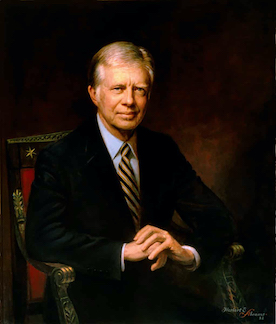Jimmy Carter was sworn in as the 39th president of the United States on January 20, 1977. He became president by defeating incumbent Gerald Ford in a very close election. Carter had promised more integrity in government and, along with his vice-presidential pick, Walter Mondale, had campaigned on the theme of honesty, promising, “I’ll never tell a lie.” His greatest political success in office was brokering the famous Camp David Accords in 1978 between Egyptian president Anwar Sadat and Israeli prime minister Menachem Begin. He also re-opened diplomatic relations between the U.S. and China, while breaking ties with Taiwan, and got a SALT II treaty signed with the Soviets. His biggest challenge occurred on November 4, 1979, when Iranian students laid siege to the American Embassy in Tehran, taking 52 hostages in the process. The hostages were held captive for 444 days. President Carter would later blame the hostage crisis for his failure to win a second term as president. The hostages were releases just after Ronald Reagan was inaugurated as the 40th U.S. president on January 20, 1981.

Working the Iowa State Fair for support, Georgia Governor Jimmy Carter defied the odds, coming out of obscurity to capture the 1976 Democratic Presidential nomination for President, running against incumbent Republican candidate Gerald Ford. (Credit: AP)

On the podium at the 1976 Democratic National Convention in New York City, Georgia Governor Jimmy Carter and his running-mate, Minnesota Senator Walter Mondale, acknowledge the convention crowd as they accept the party’s nomination as standard bearers for the upcoming election. (Credit: Warren K. Leffer/Library of Congress)

President Jimmy Carter addressed the nation on February 2, 1977, in fireside chat, to discuss his administrations energy policies and plans for the future. He was dressed in what was to become an iconic, folksy yellow sweater for the speech. Today the sweater is on display at the Carter Presidential Library and Museum in Atlanta, Georgia. (Photo Credit: Carter Presidential Library and Museum)

U.S. President Jimmy Carter and Soviet General Secretary Leonid Brezhnev put their signatures on the Strategic Arms Limitation Talks (SALT ll) treaty at the Hofburg Palace in Vienna, June 18,1979. (Photo Credit: Bill Fitz-Patrick)

Historic meeting between Egyptian President Anwar Sadat, Israeli Prime Minister Menachem Begin and U.S. President Jimmy Carter after signing the Camp David Accords at the White House on Sept 17, 1978. As a result of the agreement, Sadat and Begin shared the 1978 Nobel Peace Prize. (Photo Credit: CNN)

On November 4, !979, Iranian student protesters stormed the U.S. Embassy in Tehran, taking 52 diplomats and citizens hostage for 444 days. The Shah of Iran had recently been overthrown at home and taken refuge in the United States. The protesters wanted the Shah returned to Iran. President Carter refused their demands and the hostage crisis went on until President Reagan was sworn in to office January 20, 1981. (No Photo Credit)




